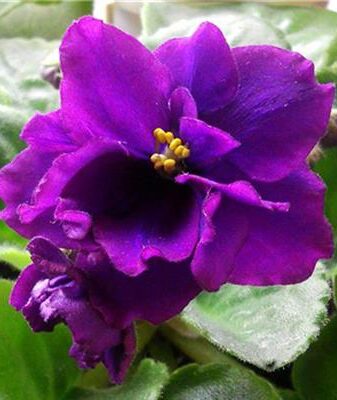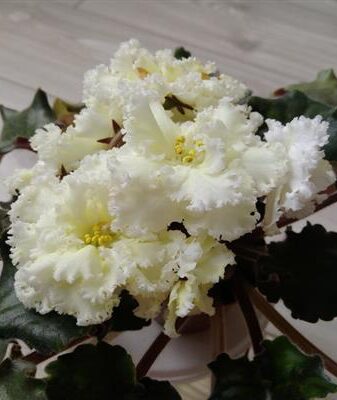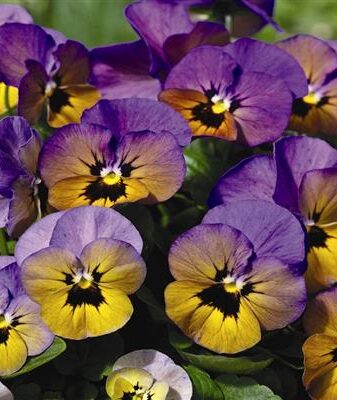Violet Yesenia
Content:
Violet Yesenia: variety description and characteristics
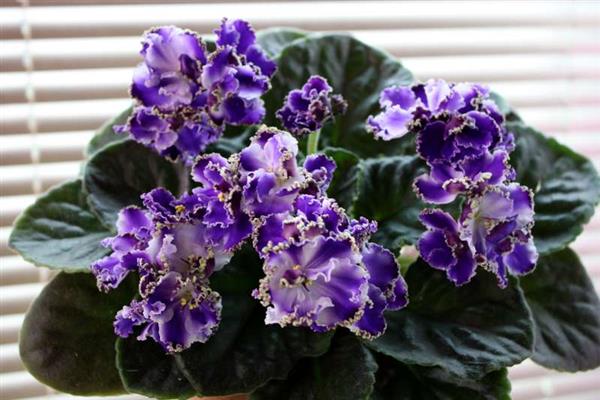
Violet Yesenia: photo of the variety
Violet Yesenia characterized by purple double flowers, bordered along the edges of the white-greenish thinnest ruffles. This is a distinctive feature of this variety, a highlight. The rosette is standard up to 40 cm, it is formed even, the leaves are not elongated, which is why the plant looks neat and well-groomed. The color of the flowers can be from dark blue to almost white with a purple tint, depending on growing conditions and other factors. The flowers themselves open for a long time, the flowering period of one flower is about 2 months. 7-8 flowers 3-5 cm in size are formed on one peduncle. The root system is in the form of small identical petioles. With a lack of lighting, the peduncles stretch out and fall off. The intervals between flowering are small, about 2-4 months, so flowers delight you almost all year round, even in winter, only in summer the color can be richer, and in winter a little more white. As a rule, violets like cooler weather, regardless of the variety, then the colors will be more successful.
Violet Yesenia: cultivation of a variety
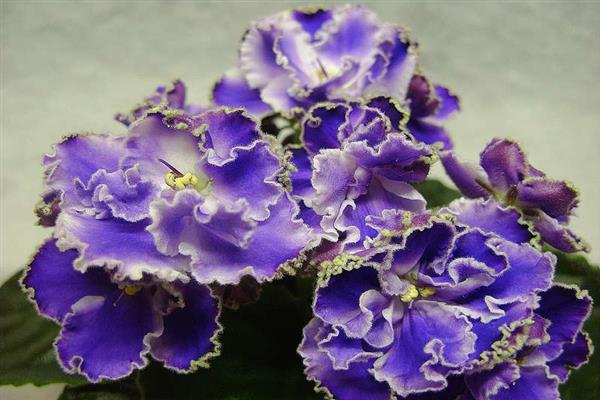
Violet Yesenia: photo of the variety
As we have already noted, the color of the flower of the Esenia violet variety directly depends on the room temperature. If you want the flowers to be deep blue, then you need to choose a warm room. And if you want a white and blue color, then the temperature should not exceed 20 degrees. Like all indoor plants, the violet Saintpaulia does not like sudden changes in temperature, sharp direct light, the humidity should be maintained within 70-80%. The best place for growing the Yesenia violet variety will be the western or eastern window sills, if you notice that the rosettes began to reach for the light, stretching and deforming, it means that the place is not suitable, you need to choose a more illuminated one. Artificial lighting is possible, just take into account that there must be a distance of at least half a meter between the light source and the flower. To activate the flowering hormone, a violet needs eight hours of darkness a day. Violets love the same conditions as a person, so you can navigate exactly on this. For example, a comfortable temperature is 21 degrees, if the temperature drops to 15 degrees, then most likely the plant will die. Drop leaves are a sure sign of death. If your house does not have enough humid air, you can resort to this trick: pour pebbles into the pallet and sprinkle them with water, so you will maintain optimal humidity. Do not make the windowsill too crowded, you need to leave room for air circulation, because if the plant is infected with some kind of disease, then it will not be possible to save the rest of the plants with close contact.
Violet Yesenia: variety care
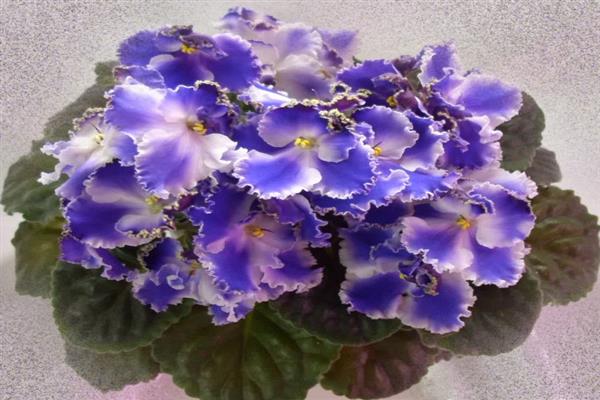
Violet LE Yesenia: photo of the variety
- Watering
Watering is needed more moderate, stable. It is very simple to check the need for watering, it is enough to lower your finger a little into the soil, if it is dry to a depth of 1 cm, then you need to water the plant. The best watering method is the bottom one, but it is inconvenient enough for constant use. It consists in the fact that we pour water into the pallet, after 20 minutes we remove the remaining water from the pallet. The water temperature should be at room temperature, it is not recommended to use too cold water. Another important condition is that it is necessary to use tap water, because when using a filter, the water loses its hardness, and pouring with such water you will change the acidity of the soil. This, in turn, will lead to the fact that the plant will forget how to perceive nutrients.The most important thing to be guided by when watering violets is the condition of the soil. If it is dry, water it. In winter, you may need half as much watering as in summer.
- Fertilization
Fertilizers are applied during the flowering period of violets. Special ready-made mixtures for indoor plants are suitable. You can make it yourself, the fertilizer must contain potassium, phosphorus, nitrogen. At the same time, phosphorus should be approximately two times more than other components. Fertilizer is applied once every two weeks, during flowering, the rest of the period is not necessary. But, if you notice that the violets look bad, have faded, began to fall off, spots have appeared, then there is a lack of nutrients. In this case, we apply additional, unplanned fertilization. And if the plant looks good, according to its external signs, it does not require additional care, then 1/4 of the required rate can be added. You can easily read the rate of application of this or that fertilizer on the packages of ready-made mixtures.
- Pruning
Violet LE Yesenia does not belong to the number of plants that require pruning, but nevertheless, damaged leaves with signs of disease must be removed, as well as faded flower stalks. During the period when new flower stalks are formed, the rosette takes on the shape of a sphere, as if it is reaching for the light. In order to help the flower bloom faster, thinning of the leaves is carried out. This procedure will significantly accelerate the growth of peduncles. Look closely at the leaves for signs of various diseases. Any deformations of the plant are signs of a disease, therefore it is very important to remove damaged areas in a timely manner. Cutting technology:
- First of all, we process scissors
- We cut off all damaged areas of the plant
- We process the scissors again
- After two or three days, we again inspect the plant, if there are new damages, we prune again.
- Then we check every day or at every watering, if there are any damages, we repeat the same procedure
The most important condition is compliance with the disinfection of devices (scissors), because most diseases are transmitted precisely from not disinfected scissors.
- Transfer
The best time to transplant the Yesenia violet variety is spring, after the violet has faded, and to be at rest. At this time, she will most easily transfer the transplant. Some growers believe that transplanting into a different soil should be done every year, because the soil is depleted. But provided that you apply the fertilizing the required number of times, then this is not an entirely correct decision. A transplant is done only if the plant has outgrown its pot.
Transplant technique:
- choose a pot 1 \ 3 more than the transplanted plant
- we make up the planting mixture: peat moss (sphagnum), perlite and sand in equal parts
- we moisten the soil
- take out the violet from the old pot
- make a drainage layer at the bottom of the pot, then fill in the soil mixture
- place the violet in the center of the pot
- fill with soil to the end of the pot
- water the violet after planting
Reproduction
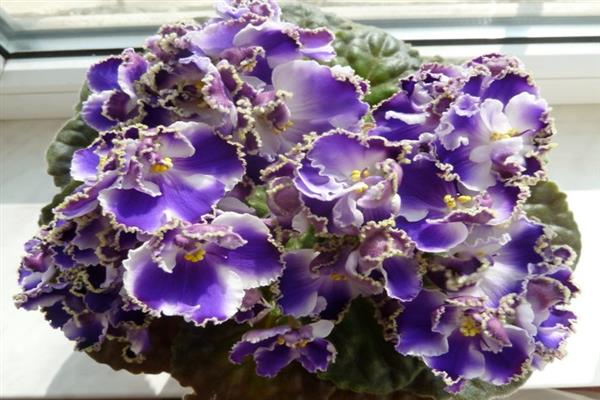
Violet Yesenia: photo of the variety
Violet Yesenia propagates by seeds, leaves or parts of leaves. The most popular type of propagation is with leaves. This method is the easiest, and at the same time you will retain all the features of this variety. Breeding technology with a leaf:
- First you need to choose a healthy, large leaf. Important! Old leaves are not suitable for propagation.
- To accelerate germination, you can cut off the top of the leaf, so that 75% of the plate remains.
- We choose the same soil mixture as in the case of a flower transplant.
- Moisten the soil with water
- We place the petiole in the ground, not reaching the leaf.
- We cover the leaf with a plastic container or film, creating a greenhouse effect
- After some time, a new plant should appear next to this leaf.
In six months, it will already be a full-fledged plant with its own root system, ready to bloom. You can move the pot to a permanent place and apply all the rules for caring for an adult plant.
Diseases and pests
Most of the problems associated with disease arise from improper care. For example, improper watering, or rather overflow, can affect, planting a flower too deep in the ground can also provoke disease. All pests of violets mainly move in the air, so there are practically no methods of protection, but their attack can be minimized. Damaged leaves, for example, gnawed leaves, the presence of larvae on the plant, can serve as signs of the presence of pests. Spraying with insecticides is suitable as a fight. To do this, first we protect the plant from others, close it with a plastic bag, then we spray it, this is done in order to protect other plants from pests. Besides insect pests, violets can get rotten. The signs of the disease are considered to be a slowdown in the growth of the violet Yesenia, withering and falling leaves, various dark spots on the leaf plate. We carry out the treatment as follows:
- First you need to pull the plant out of the pot along with the roots.
- We inspect the roots, remove damaged areas
- We also remove damaged areas on the plant itself.
- We completely treat the entire plant with fungicides
- We transplant the violet into a new pot with new soil.
After that, it is necessary to control the watering of the plant, to prevent waterlogging. Violet Yesenia is a rather unpretentious plant; with proper care, it will delight you for a long time with its flowers and long flowering. In the presence of sunburn, which appear in the form of light spots on the leaves, the violet of the LE Yesenia variety must be protected from direct sunlight.


